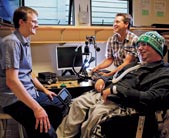Getting back in the game with CanAssist’s Accessible Gaming Controller
by Peigi McGilvary

and Dale Hampshire.
PHOTO: NIK WEST
It wasn’t until CanAssist at the University of Victoria started to work with Dale last year that he was able to get back in the game, with the help of a custom-designed video game interface that he controls by ‘sipping’ and ‘puffing’ on a tube held in his mouth.
CanAssist helps people of all ages and across the disability spectrum to improve their quality of life. The organization’s team of engineers, software specialists and program coordinators develop innovative technologies and programs where there are gaps in existing services. The team works closely with UVic students and faculty, along with partners in the wider community.
“CanAssist’s goal is to understand and respond to people’s specific needs and to help them increase their independence,” says Paul Green, an electrical design specialist at CanAssist. “Dale was looking for something that would let him return to video gaming without having to rely on someone else’s help.”
With funding from the BC Ministry of Health, the CanAssist team customized a device for Dale that it had developed the previous year for another client. Called the Accessible Gaming Controller, the device acts as an intermediary between a user’s accessibility controls and popular gaming systems.
“CanAssist is really good at working with people to meet their needs,” says Dale. “They make sure they include your input to create a device that works for you.”
“Dale needed something that would connect the accessibility switches he already uses every day—like his sip-and-puff device—to commercial gaming systems such as the PlayStation and Xbox,” says Carl Spani, senior electrical design specialist. Spani says accessibility switches can be buttons, joysticks, sip-and-puffs or other devices that allow people who have difficulty using their hands to control many types of technologies.
The Accessible Gaming Controller can be connected to a wide range of accessibility switches, and then connected directly to Sony’s PlayStation, Windows computers or Microsoft’s Xbox. It can be configured to replicate different gaming systems’ controllers, and can be customized and mounted to meet each user’s requirements.
Like commercial systems, CanAssist’s device enables users to play with other gamers, whether they’re in the same room or—via the internet —on the other side of the world.
“The exciting thing is that the system is so seamless,” says Green. “It doesn’t add any time lag and it levels the playing field between players using standard controls and those using our accessible controller. It creates a feeling of real competition and accomplishment.”
And Dale? Well, he is thoroughly enjoying exploring all the games that have been developed since he last was able to play, and is once again involved in a highly entertaining activity that gives him a strong sense of inclusion. Dale says, “It’s given me independence and freedom to do a normal activity that can be hard for people with disabilities.”
Game, anyone?
View as PDF (644K).
CanAssist: helping people live independently
In the late 1990s, an occupational therapist asked Dr. Nigel Livingston if he would be able to design a switch to help a young man with multiple disabilities control a tape recorder on his own.
That single interaction—and the delight of one young man for the bit of autonomy the device gave him—lit a spark. Livingston went on to found UVic’s CanAssist program in 1999. Since then, CanAssist has helped hundreds of clients and provided meaningful learning opportunities for thousands of students in areas such as developing technologies, participating in research and volunteering.
“CanAssist wonderfully demonstrates some of the hallmarks of UVic: the integration of teaching and research, hands-on learning experiences for students, community engagement, the creation of innovative technologies and knowledge mobilization for social benefit,” says Dr. David Turpin, President and Vice-Chancellor of UVic. “It also supports our commitment to inclusion.”
Info: canassist.ca